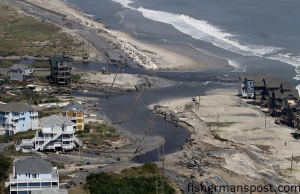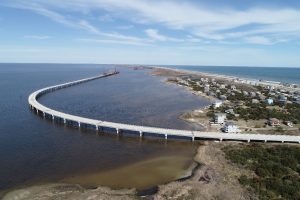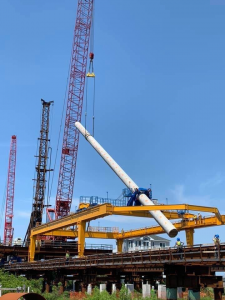April 21, 2022 1:00 pm
David Peterson, P.E., Director, Structures, RK&K; Jeremy Keene, P.E., Project Manager, Structures, RK&K; and Sean O’Neal, Preconstruction Manager, Flatiron
Webinar Documents:
North Carolina’s Rodanthe “Jug Handle” Bridge: Precast Bridge Elements and Innovative Construction Approach - pdf of presentation
Q&A Session - pdf
News - April 21, 2022 - pdf of presentation
Description: The town of Rodanthe is on the Outer Banks of North Carolina between the Pamlico Sound and Atlantic Ocean. Heavily traveled by vacationers in the summer season, NC 12 is also the sole land evacuation route for coastal storms. Several times a year, sand and coastal over wash closes the stretch of road known as the “S” curves for days at a time. After years of constant maintenance, NCDOT advertised the Rodanthe “Jug-Handle” Bridge design-build project in 2013 and awarded the project to the Flatiron/RK&K team several years later. Flatiron/RK&K utilized many precast bridge elements and construction techniques to accelerate the construction timeline of the bridge. Precast cylinder piles, beams, deck panels and sheet piles were used extensively throughout the project. Construction of the bridge was done by utilizing an advancing rail system with gantries and cranes perched above the permanent structure and advancing forward as spans were completed. The completed bridge opens to traffic in April 2022.
Presenters:
David Peterson, P.E.
Director, Structures
RK&K
Email: dpeterson@rkk.com
David received his Bachelor’s degree in Civil Engineering and a Bachelor’s in Political Science from Virginia Tech in 1982 and 1983, respectively. Since that time he has held numerous engineering positions as well as making generous contributions to ASCE. He currently works as a Director of Structures for Rummel, Klepper & Kahl, LLP, in Raleigh, NC. Over the years, he has worked on hundreds of bridges in 10 states with various consulting firms. He is a licensed professional engineer in North Carolina, Virginia, South Carolina, Florida, Georgia, Tennessee and Maryland.
Jeremy Keene, P.E., DBIA
Project Manager, Structures
RK&K
Email: jkeene@rkk.com
Jeremy is a structural engineer responsible for the design and inspection of curved and straight steel, reinforced concrete and prestressed concrete structures, with an emphasis on bridge design. He has both Design-Bid-Build and Design-Build experience providing structural services on projects for the DOTs across the southeast. His experience includes highway, rail and pedestrian structures. Jeremy is also a certified bridge inspection team lead with experience performing element-based inspection and ratings on an array of structures across the state of North Carolina.
Sean O’Neal
Preconstruction Manager
Flatiron
Email: SOneal@flatironcorp.com
Sean has nine years of experience working in the heavy-civil and moveable-bridge construction industries. He has a history of success in Bid-Build, Design-Build, and Construction Manager at Risk (CMAR) project delivery methods for DOT and railway clients throughout the Mid-Atlantic and Gulf Coast regions. Sean holds a Bachelor of Science degree in Civil Engineering from North Carolina State University.
Presentation Photos/Graphics:
3) This rendering of the advancing rail system shows each of the construction operations that occur. The lead crane builds the advancing rail system while the following crane drives the prestressed concrete cylinder piles. The gantries roll along the rail system and construct the caps, set the girders and deck panels. All materials for the bridge are delivered from the completed section of the bridge. The trailing crane then removes the advancing rail system components and they are carried forward on the train car for re-use.
4) The pile driving and tripping crane lifts the head of the 54-inch-diameter prestressed concrete cylinder pile with the help of the tripping frame. The crane would then lift the pile and set into place in the pile driving frame. Once the pile is secured, the crane would then secure the hammer and drive the pile to the required depth.








